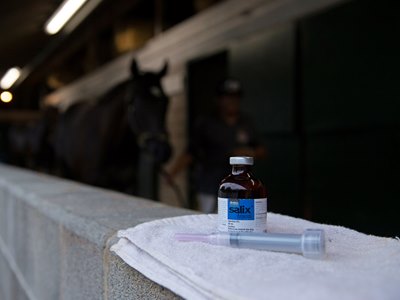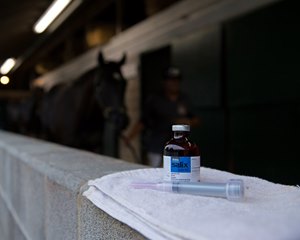Pros and Cons of Proposed Kentucky Regulations Aired


The pros and cons of proposed changes to Kentucky racing regulations that would include a phaseout of the anti-bleeder medication Lasix were aired April 22 during a public hearing conducted by the Kentucky Horse Racing Commission.
Due to restrictions related to the COVID-19 pandemic, the public was unable to attend the meeting in person, and the hearing was conducted via teleconference.
If the regulations take effect after a regulatory review process that included Wednesday's public hearing, beginning this year and moving forward, the use of furosemide, commonly marketed as Lasix, will be banned in Kentucky on race day for 2-year-olds; beginning in 2021, the use of Lasix will be eliminated in stakes races held at Kentucky racetracks.
Other major aspects of the proposed regulations, which were approved by the KHRC based on the recommendation of its Kentucky Equine Drug Research Council, would:
- Require 14 days of a horse's medical records at the time of entry, including a clear and accurate record of any treatment administered
- Extend the withdrawal time for the administration of corticosteroids from seven to 14 days pre-race
- Extend the withdrawal time for nonsteroidal anti-inflammatory drugs from 24 to 48 hours pre-race
- Eliminate the use of bisphosphonates in racing and in horses younger than 4 years old
- Require a horse to be examined by a veterinarian prior to being entered in a race to improve equine safety and add extra scrutiny of a horse's condition
The hearing, for which each party was limited to 15 minutes, exposed a divide between the Kentucky Thoroughbred Association and the Kentucky Horsemen's Benevolent and Protective Association, the two organizations that represent horsemen in the state, over the proposed regulations that have been endorsed by all four Kentucky Thoroughbred tracks.
"We believe these changes, especially the expanded veterinary record-keeping, protect our participants, horses and licensed persons, and the public, including bettors and fans equally," said KTA executive director Chauncey Morris, noting the organization supports all the proposed regulations. "Once Kentucky racing resumes, these changes will foster an upward trend of our handle, field size, and quality that has been growing."
Kentucky HBPA executive director Marty Maline specifically took issue with the phaseout of race-day use of Lasix and with the requirement that a horse be examined by a veterinarian prior to being entered in a race.
Considering that horses are sometimes entered in races that do not fill and thus are unable to participate, horses could be examined multiple times before they actually run, Maline said, adding to additional costs for horsemen and logistical issues for racing offices.
On the proposed Lasix administrative regulation, Maline said furosemide has "proven to be an effective preventative to exercise-induced pulmonary hemorrhage (cause of bleeding in horses). Currently, all U.S. racing jurisdictions endorse race-day Lasix. The result of this proposed administrative regulation would place Kentucky at an isolated disadvantage that is not supported by a vast majority of Kentucky horsemen."
Dr. Clara Fenger, a racetrack practitioner who previously was a regulatory vet for the KHRC, said the proposed regulatory changes should not be adopted "at this time due predominantly to deficiencies in the evidence that is available, scientific evidence and medical evidence, to support their adoption and the strong likelihood that the adoption of these regulations will actually place Thoroughbreds at greater risk of injury during racing."
Fenger explained that EIPH is a "well-established diseased condition of racing horses. Unchecked, this disease has severe repercussions on the health of the animal, not just during their racing careers but during their entire lives. Over 90% of racing horses suffer from EIPH at some point during their racing and training careers. Furosemide, or Lasix, is well established as the only known means of preventing EIPH."
Dr. Andy Roberts, a racetrack veterinarian and member of the EDRC, said horses "are put at greater risk by not using a legitimate therapeutic medication" to treat EIPH.
Roberts, whose practice includes both Thoroughbreds and Standardbreds, said the proposed corticosteroid rule could have negative effects, particularly on Standardbreds.
"If the regulation were followed as written, a horse would not be able to race for three weeks after injection," he explained. "The reason for that … a Standardbred races on a seven-day schedule. If you have a 'Saturday night' horse, that horse races back the following Saturday night. If you give them a 14-day withdrawal period for the corticosteroids, it couldn't even race on the second Saturday. So they would essentially have a 20-day interval between racing. In Standardbred racing, if you have a 30-day interval between racing, you're not allowed to race without re-qualifying your horse.
"There is no science that indicates this would do anything beneficial to the horse," Roberts added. "I don't want the horses to suffer. I don't want the horsemen to suffer."
Roberts suggested that the proposed administrative regulations be given additional attention before being adopted.
"I think we need to have a plan that actually puts the horses first, and neither of these proposed changes do that as written," he said. "I think we need to have a bigger picture and go back to the drawing board and getting everybody to the table."
Dr. Mary Scollay, the executive director of the Racing Medication Testing Consortium, said the organization supports the proposals relating to corticosteroids and nonsteroidal anti-inflammatory drugs and to prohibit "stacking" (being given two or more steroids) of both types of medications.
"The 14-day stand-down period and the 14-day prohibition on stacking both are intended to improve equine safety in that they allow the trainer and the horse's connections, attending veterinarians, and regulatory veterinarians the opportunity to monitor that horse's soundness and make appropriate decisions with respect to entry," Scollay said.
